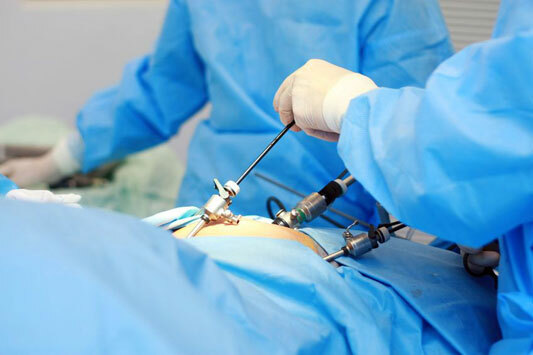Polycystic ovary syndrome( PCOS) is a fairly common cause of female infertility. However, even despite its presence, very many girls manage to become pregnant and eventually give birth to a healthy baby. Most women who were diagnosed with this diagnosis are interested in whether it is possible to become pregnant with polycystic ovaries and how difficult it was to conceive in those who became pregnant with polycystic disease. Sometimes conception is quite possible without adjuvant therapy, but in most cases, special therapy or surgery to remove cysts is necessary.

What should I do?
Polycystic ovary and pregnancy can be completely compatible concepts. It is not always necessary to treat the condition. If the girl has a regular menstrual cycle, then conception is possible without prescribing medication. Often gynecologists predict the onset of pregnancy during the year. During this period, women are advised to monitor basal temperature. This will provide additional information about the days when conception can occur with greater probability. If a woman does not become pregnant within a year, then this condition should be treated. If the monthly irregularity is also prescribed a course of treatment, after which it is possible to become pregnant approximately six months later.
Use of contraceptives
How to cure polycystic ovary to get pregnant - tells the doctor. Contraceptives are the very first aid for the treatment of pathology. Of course, that during their reception, the onset of pregnancy is impossible. The course of treatment lasts about six months, after which conception is possible. This is due to the fact that the contraceptive pills allow to normalize the irregular menstrual cycle, thereby provoking normal ovulation. Most often, doctors prescribe drugs that have an antiandrogenic effect. The choice of the drug is exclusively the attending physician.
Ovulation Stimulation
One of the symptoms of the pathology is irregular menstruation, without the onset of ovulation. The process is controlled by ultrasound of the small pelvis or special tests, however, they are not always reliable. At such a confluence of circumstances, gynecologists can recommend stimulation of ovulation.

This procedure is a course of treatment in which the administration of hormonal drugs is administered enterally or parenterally. Due to drugs, the follicle that releases the egg is ripening. This is ovulation, the day of which you can successfully conceive a child.
Preparation for the procedure and procedure for the
Before the treatment it is necessary to check the quality of the sperm in the sexual partner. You should also make sure that the tubes are passable, otherwise there will not be any sense in treatment.
The future dad should pass spermogram, a woman undergoes hysterosalpingography - allowing to assess the patency of fallopian tubes. Also it is necessary to be surveyed on TORCH-infection. If the tests gave good results, then you can start to stimulate ovulation.
It is carried out by hormonal means - Klostilbegit, Klomid, Dyufaston, Horagon, which are prescribed in various combinations on the basis of the level of hormones. Drugs are taken in those days, which indicates the gynecologist, he also determines whether pregnancy with polycystic ovaries is possible.
One of the most common treatment regimens:
- Clostilbegit from the 5th to the 9th day of the cycle;
- Conduction of ultrasound of the small pelvis, which determines the development of the follicle and endometrium after the 10th day of the cycle. When the follicle reaches a diameter of 18 mm, the next stage( the 15th day of the cycle) is performed;
- Injection of chorionic gonadotropin. It allows you to achieve the release of the egg with the subsequent onset of ovulation. On this day, a woman is recommended to have sexual intercourse for the purpose of conception;
- A day after the introduction of the chorionic gonadotropin, progesterone preparations are prescribed - Dufaston, Utrozestan. They are necessary to support the yellow body. The course of admission is 10-17 days, then repeated ultrasound is assigned to determine the onset of implantation of the embryo into the uterine endometrium.

This diagram is just an example. Your gynecologist can change it depending on the results of the examination, but it helps to answer the question of how to get pregnant with polycystic ovaries.
In case of ineffective stimulation of ovulation
There is a situation where the procedure for stimulation of ovulation does not give the desired result, and the follicle does not grow to the right size. Then the gynecologists increase the dosage of hormones in the next cycle. With each of them, the dose continues to grow until the follicles ripen sufficiently, with a maximum dosage of 200 mg, and a further dose increase is ineffective.
The problem is not hopeless, since after that drugs from another group that have a similar effect can be used. These are menopausal gonadotropins( Menopur, Gonal).They are introduced in the first three days of the cycle. Simultaneously with their introduction, control of the development of follicles through ultrasound is carried out. As soon as they mature to the desired size, the continuation of the stimulation proceeds according to the scheme described above, but not from the first, but from the third point.
Adverse effects of
It should be noted that stimulation of ovulation, like many other methods of treatment with medications, in particular with hormone-containing drugs, can lead to various side effects. This means that this procedure should be carried out exclusively under the close supervision of a gynecologist who can promptly help or interrupt treatment if undesirable consequences develop.

The most common side effect of this manipulation is the ovarian hyperstimulation syndrome, in which several follicles can ripen in the ovaries. This can provoke the development of pain and discomfort in the lower abdomen. Sometimes a small amount of fluid accumulates in the abdominal cavity. If the ovaries have increased significantly, then they can burst. In order to control the flow of stimulation of the ovaries, as well as for the timely diagnosis of the hyperstimulation syndrome, regular ultrasound of the pelvic organs is necessary. The days when the examination is being conducted is indicated by the attending physician.
A few words about Metformin
Sometimes gynecologists say that you can get pregnant with Metformin, which can often be prescribed for the treatment of polycystosis. It should be noted that this drug is not intended for infertility therapy, however, in studies it is noted that when the drug is taken, the menstrual cycle normalizes and ovulation occurs. So, its use is appropriate for the treatment of infertility. At the same time, female infertility is often diagnosed by endocrinologists, who, in addition to referring a woman to a gynecologist, may recommend metformin to the question: "How to get pregnant with polycystic ovaries?"
The drug itself is intended for the treatment of non-insulin dependent diabetes mellitus, but even if you have not found this disease, its use can speed the onset of conception. Also, in scientific studies, it is noted that taking metformin before performing the procedure for stimulating ovulation can reduce the immunity of the organism to Klostilbegit.
The effect of this drug on the course of polycystosis and the onset of pregnancy to date has not been fully understood, so most doctors recommend it only when a woman has a carbohydrate metabolism disorder.

There is also evidence that Metformin can be taken not only when planning pregnancy. Scientists say that it is shown in the first trimester, because it can reduce the likelihood of miscarriage in polycystic ovaries. However, it should be noted that the effect of the drug on the fetus is not fully understood. Therefore, doctors and women who decide to use it, should think several times about the advisability of this method of treating infertility and preventing miscarriage.
Laparoscopic surgery and how it can help.
Laparoscopic surgery is performed under general anesthesia. Its distinctive feature is that a large incision is not performed on the abdomen. The surgeon makes several small incisions for the endoscopic instruments with which he performs the operation. The recovery period takes much less time, as tissue traumatization is insignificant. Sutures are also removed for 7-10 days, but their number is much less.
The most frequently performed resection of the ovaries. It involves the removal of those parts of the body where the capsule is significantly thickened. This allows you to achieve ovulation through time through the openings in the capsule of the organ performed during the operation, and also to lower the production of male sex hormones that are synthesized in the capsule.

Usually, pregnancy is possible already during the onset of the next menstrual cycle. Given the statistics given the query "polycystic ovary and whether it is possible to become pregnant with it", the occurrence of pregnancy during the year is possible more than in 90% of cases. Also, the overwhelming majority of girls and women who underwent laparoscopic surgery are recovering the menstrual cycle.
Polycystic and miscarriage
The risk of miscarriage, as well as the onset of a stiff pregnancy in the case of polycystic is somewhat higher. The cause of these pathologies is a pronounced violation of the hormonal balance. Also, development of gestational diabetes mellitus, hypertension, eclampsia and premature birth is possible. Women with a similar problem should be constantly under the supervision of a doctor.
From the psychological point of view with polycystic ovaries, thoughts should not be directed to the question: "How fast to get pregnant?".A systematic preparation for conception is necessary by means of a thorough examination to determine the appropriate therapy.
It is strictly forbidden to self-treat the syndrome of polycystic ovaries, as it can aggravate pathology. This is due to the fact that the main drugs for treating the problem are hormonal drugs. Therapy of the disease should be carried out exclusively by an experienced doctor.



